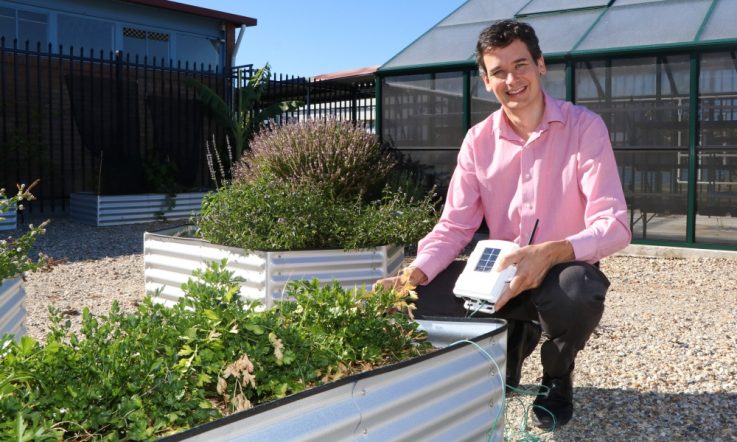This podcast from Teacher magazine is supported by EnhanceTV. EnhanceTV is used in thousands of Australian classrooms to stream educational videos that engage students. EnhanceTV is a not-for-profit, which means more value to educators. EnhanceTV is completely free to K-12 teachers – for more information visit enhancetv.com.au/free
Hello, thank you for downloading this podcast from Teacher magazine – I'm Jo Earp.
In this episode of The Research Files I'm joined by Dr John Halsey, former teacher and principal and now Emeritus Professor at Flinders University. His final report on the Independent Review into Regional, Rural and Remote Education here in Australia explores the key issues, challenges and barriers affecting student learning outcomes and suggests four priority areas for action.
Jo Earp: Dr John Halsey, welcome to The Research Files. Now, one of the remits of the review was to examine the gap in educational achievement between school students in regional, rural and remote areas and their metropolitan counterparts. So, can you start with a brief overview of these differences in achievement?
John Halsey: Thanks Jo, good to be here, yes I can. In a nutshell, the further you go out from a large population centre and in particular a capital there's a downhill decline. Of course there are exceptions to this, but overall in terms of the national literacy and numeracy data, in terms of school completion rates, in terms of transition to quality post-school higher education or training, in terms of PISA results and TIMSS results internationally – in all of those there seems to be, well not there seems, there is a factor that is at play in terms of remoteness, or rurality as some have called it. As I've said, it varies from place to place and as I wrote in the discussion paper an average score of 50 in cricket can hide a couple of centuries and a few ducks. So, that's one way of thinking about it. But, taken overall, that's the picture.
JE: So clearly an issue to be grappled with then here in Australia. I mentioned in the intro that your report suggests four priority areas for action. I'll quickly go through those. Firstly, establishing a national focus for regional, rural and remote education. Secondly, leadership teaching, curriculum and assessment. The third priority you've identified is ICT and the final one is student transitions into and then out of school into careers and life after school. Focusing on that second area then, what are some of the challenges you found during your review in relation to school leadership first of all?
JH: Well, in school leadership – there are a couple of big issues there. One is that, typically, rural, regional and remote schools are someone's first posting as a leader (not exclusively), so it's the experience base. Secondly, many of our schools in rural, regional and remote areas are small – there are a bit over 2000 schools in Australia with less than 100 students, and most of those are in rural, regional and remote areas. And, the size of the school, the staffing complement, the administration and the inexperience – when you wrap that all together – presents significant issues in terms of leadership. You also have the added dimensions of building relationships with community and sustaining those relationships.
And, one of the factors in very small communities is something that I call ‘high surveillance and low anonymity' and by that I mean you live the role 24/7/365 – it's not really 365 because there are some breaks, but you know what I mean. It's a 24/7 role in a community and that brings its added complexities. As well as, frequently, school principals, school leaders in small communities have a range of extra responsibilities – which usually aren't found in larger centres and certainly not in metropolitan areas – to do with teacher housing, bus services, accessing specialist services to support students, and just coming to grips with the whole issue of distance. And then, back inside the school again, class formation, designing learning programs with small numbers of students across a wide range of grade bands or year levels.
JE: So, some different challenges there for principals. What about for the role of teaching – I'm guessing some of those things will still apply in terms of attracting and retaining staff. But you also talked about [in the report] the need to allow teachers in these areas to adapt the curriculum to suit local contexts.
JH: Yes, well you've got the attraction/retention, you're right, and also you've got the experience base – again, typically in Australia we've sent our least experienced teachers to some of our most challenging remote schools contexts, with the promise of permanency or a long-term contract or something as an incentive, so you've got that. Then, in terms of adaption to local context and thinking through how the curriculum might relate – one of the things I found in the review, both in some of the written submissions and in some of the meetings I had with teachers and parents – they were seeking greater capacity to respond to local context, to build the curriculum around that. To not disconnect themselves from the big picture if you like, from the nation as a whole and from the importance of standards and levels of achievement, but have a much more responsive approach to things, which could also lead into opportunities for entrepreneurship at a local level. Some of this applies in particular to remote Indigenous schools, where you have still very strong traditional practices, very strong traditions of language, of living on Country, of ceremony. And I think there's still significant scope to think about how more productive/beneficial blends of modernity if you like, or a western conceptualisation of curriculum, and tradition can come together in some new productive mix.
JE: You touched on entrepreneurship education there and I want to come back to that later on. But to look at some of the possible solutions to these challenges, in terms of teaching and leading, in the report you say: ‘During my discussions with leaders of small schools, it became very apparent there is significant potential to free up more of a teaching principal's time for teaching and supporting learning by reducing their administration load.' One suggestion you make is by setting up clustering or partnership approaches. Can you explain a little bit about those?
JH: Yes, well there are quite a few of those at the moment and I think there's significant capacity for more. Putting it, I suppose, in a nutshell there is capacity to generate some efficiency by coming together to get common tasks done in a more centralised, common way rather than replication in five or six small sites.
What I was thinking of are things like: in a cluster of schools or a cluster of partnerships, a school manager, school bursar, school clerical person, admin officer who works between the sites and across the sites to take care of (and I don't mean this in any diminishing sense) routine accountabilities and so on. When I was out in the field meeting and starting to drill down on this one principal of a small school said to me ‘you know, we can get 150 emails [in a very short space of time]' – I think I quoted it in the report. I couldn't verify that in terms of ‘show me every email', but a few colleagues in the room all nodded.
Another factor, not only in a cluster-based arrangement, another thing that needs to be thought about is a more differentiated communication out to sites and out to schools, cognisant of the fact that in some schools teaching principals have significant classroom contact and yet have to address systems issues as well, and surely there are ways to have a better targeting approach to things. And, therefore free up time for teaching and for focusing on the learning needs of the students. I think this same factor has come through David Gonski's most recent report that's just been out for the last couple of days, looking again at the administrative dimension of things, versus the more unadulterated educational leadership, curriculum, teaching, learning.
JE: In your report, in that final report, you do go through some promising approaches and case studies and so on, so I would urge people to have a look at that. You say that committed and highly effective teachers and teaching at every year level and in every location is essential. There are a couple of things you talk about – firstly the need for better preparation for those about to teach in rural, regional and remote areas. But also the importance of growing the expertise of educators already [working in] those locations. Can you expand on that second area a little – growing that expertise of existing staff?
JH: I think I can. When I was in I think it was Narrabri, I was in a consultation group there where what seemed to be very much alive and well was a very substantial and significant in-school professional development program – I think it was in a cluster of schools – a strong partnership between a regional university, some really good academics had done very appropriate and relevant research, and a school which was committed to that, to teacher development, and had made it a priority in a very targeted way. And what the data had shown was that significant gains were being made, not only on the teacher expertise front, but also starting to pay off in terms of student learning achievement.
So, in a nutshell, it would be (as I've said I think in the report), we need to continue to focus on high quality, localised at the point of where the teaching and learning actually occurs – there is a role for going elsewhere and going to large conferences and hooking up internationally on ICT and so on – but actually rolling your sleeves up with some external expertise in a sustained way in the site where you actually do your teaching work with the students. I think that's very, very significant, because as everybody is probably aware listening to this, when you leave a site and move out and come back (particularly the more remote ones) you're often talking two, three, four, five days for supposedly one day of benefit. And there is both, from practice sense and also from research, some of the residual benefit of that quickly diminishes.
JE: So, we've talked about staffing and expertise there. Finally, I'd like to touch on one of the learning areas you say was raised in several of the review submissions, and you also did 31 consultation sessions held across the country and it was raised there as an important contribution to reducing that achievement gap that we mentioned right at the beginning – that's entrepreneurship education isn't it.
JH: Yes … I think there's significant untapped capacity to explore the role of entrepreneurship and its impact on students' learning from two perspectives. One is, in basic terms, improving outcomes. But the other one is in terms of motivation and engagement relevance. And also very importantly for small, rural communities which are going through major transitions economically, to actually develop new futures, new economic futures for the area, for a town or in fact for a region. Because, bottom line is many of the small schools are in decline, not only because of changing family size and amalgamation of farm sizes and so on, but the closing down of industries or the economic base, as well as the rationalisation of government human services.
So, there are examples of schools that have worked very closely with the community to actually [contribute towards] developing a new economic base for the town, and in a sustainable way, that has had the benefit of changing the employment profile and indeed retaining some of the young people in the community, so that there is a future for the town as distinct from an ageing profile. That has happened – I don't know whether it can happen everywhere, but I've certainly seen examples of it. I've seen it in Western Australia, I've seen it in South Australia, I've seen it in the Northern Territory, in rural Queensland, New South Wales, there are very good examples of that and I think it's an [undertapped approach] that we could continue to build on.
JE: Excellent, well, as I say there's lots more information in your report. In addition to the four priority areas you've made 11 recommendations, and that's accompanied by 53 actions to progress them. We'll include a link through to the full report in the transcript of this podcast on the Teacher magazine website for those who want to take a closer look. But for now, Dr John Halsey, thank you very much for sharing your expertise with The Research Files.
JH: It's a pleasure and thank you very much for the opportunity.
That's all for this episode – to keep listening or to download all of our podcasts for free, whether it's more on The Research Files, or our series on School Improvement, Behaviour Management, Teaching Methods, Global Education or Action Research, just visit acer.ac/teacheritunes or soundcloud.com/teacher-ACER. The full transcript of this podcast is available at teachermagazine.com.au. That's also where you'll find the latest articles, videos and infographics for free.
This podcast from Teacher magazine is supported by EnhanceTV. EnhanceTV is used in thousands of Australian classrooms to stream educational videos that engage students. EnhanceTV is a not-for-profit, which means more value to educators. EnhanceTV is completely free to K-12 teachers – for more information visit enhancetv.com.au/free
References
Halsey, J. (2018). Independent Review into Regional, Rural and Remote Education – Final Report. Commonwealth of Australia.
Dr Halsey suggests that cluster relationships between schools can drastically increase efficiency in terms of completing routine accountabilities. As a school leader, what opportunities exist to build partnerships and relationships with other schools and their staff? What are your common challenges and aims?
In terms of professional development, Dr Halsey suggests on-site learning is far more efficient and beneficial to staff. How could you go about accessing external expertise that can be brought on-site?
Dr Halsey’s final report on the Independent Review into Regional, Rural and Remote Education is available to download online (1.3MB) https://docs.education.gov.au/node/50281



